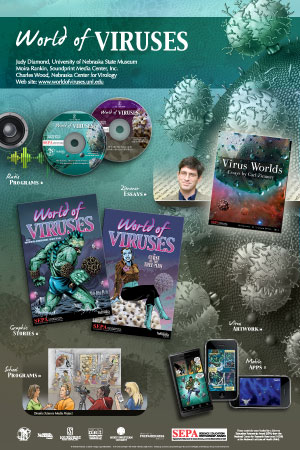
The Omaha Science Media Project is a collaboration among the Omaha Public Schools (OPS), Nebraska’s leading biomedical research institutions, nationally-recognized professional media organizations, leading science educators, and a comprehensive team of learning researchers. We propose an innovative project that uses media production – including radio, television, and multimedia formats – as an opportunity to enhance OPS high school teachers’ and students’ understanding of current scientific research. The hypothesis underpinning our proposed work is that science teachers can improve their science pedagogy by participating in intensive professional development experiences during which they produce media deliverables focused on the latest biomedical research topics; this, in turn, is expected to increase student learning and interest in science and health careers once teachers infuse their new knowledge into the classroom.
Project Purpose and Expected Outcomes
The Omaha Science Media Project will introduce an innovative approach to improve science teaching and learning at the high school level. Capitalizing upon an extensive network of scientific and educational collaborators, we plan to give OPS teachers and students in-depth opportunities to examine current virology research through intensive direct experience. Teachers and students routinely participate in research experiences; however, most are not afforded the chance to experience or understand the scientific process in its entirety.
We propose to create a new level of interaction among science teachers, students, and scientific researchers. Our project will give OPS teachers and students opportunities to directly interact with scientists – in their laboratories and at research sites. Their interactions will not be limited to a snapshot of the day’s laboratory experiments or observation of scientists engaging in discussions with one another. We will provide opportunities for teachers and students to join professional media crews to examine the research process through video coverage, multi-media products, radio interviews, and other media-based artifacts. We expect that providing opportunities for high school science teachers and students to gain expertise in science media by covering local science stories in depth will increase the effectiveness of science teaching and will improve student performance in standardized tests and standards-based science courses. More specifically, the Omaha Science Media Project has the following goals:
Improve the capacity for OPS teachers to improve the science teaching through integration of media.
Improve the performance of OPS high school students in standardized tests and science courses through teachers’ experience with Omaha Science Media Project.
Create a model pilot program focused on virology to provide a proof of concept for how integration of media with science can enhance high school teachers’ ability to increase students’ career interests in biology and health sciences.
Create an infrastructure with OPS that establishes the capacity for long-term investment in leveraging media to enhance science learning.
Establish the basis for long-term partnerships between Omaha Public Schools and Nebraska’s biomedical institutions (e.g., UNMC and UNL).
Establish the basis for a long-term partnership with two high schools in the African nation of Zambia.
Produce a generalizable model for learning research that can serve as an example not only for OPS but also for other districts that seek to engage in evaluation and learning research that effectively demonstrates the impacts of professional development in science on teachers and students.
Future Directions
The Omaha Science Media Project is designed to provide the capacity and infrastructure for an ongoing effort to improve science teaching and learning through media experiences. Following the conclusion of this pilot project, we anticipate the following:
OPS will review student CRT performance by science standard, conduct a needs analysis with department chairs to identify specific content areas of need for further exploration of continued content immersions. The district will then marry what they have learned in the virology pilot with the issues that emerge from the needs analysis to explore how to move forward with other areas of science and technology.
OPS will continue to explore possibilities for interaction with Nebraska’s biomedical research institutions, formalize its relationship with the UNMC and UNL, and establish similar connections with Creighton University and Boys Town National Research Hospital.
The evaluation and learning research developed in this project will serve as a model for future programs in OPS as well as other school districts. We expect continued interaction of the evaluation team members to solidify the OPS evaluation infrastructure, thereby improving the future capacity for research-based innovations.

The Omaha Science Media Project is an outgrowth of the five-year NIH-funded World of Viruses (WoV) project, which is a partnership among the UNSM, SMCI, and the NCV. WoV is an integrated educational media initiative to teach the public about cutting-edge virology research. The WoV project develops an integrated package of radio documentaries on current research on virology along with community-based outreach modules that include activities, essays, podcasts, and graphic files accessible via the Web. Libraries use these materials as special exhibits when stations broadcast the programs, educators incorporate activities about viruses into their teaching, and high school and middle school students directly download materials for integration into their course projects. The Omaha Science Media Project will provide professional development experience for teachers and opportunities for high school students that equip them with media skills and empower them to become more proficient at science.



